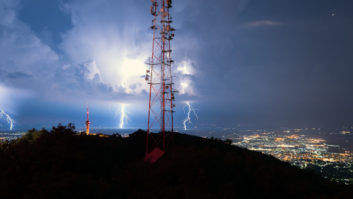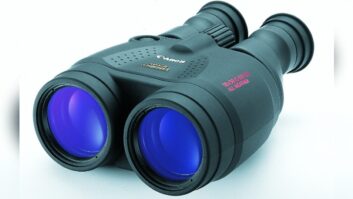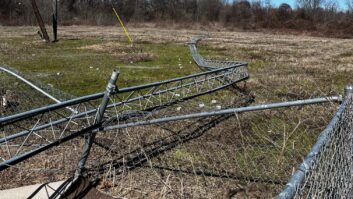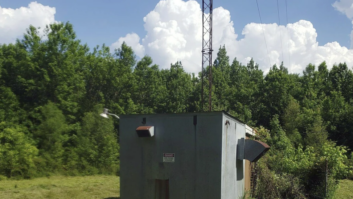If your manager has ignored your pleas for backup equipment at another location — a post- 9/11 strategy many engineers have adopted — show him or her the aftermath of this tower failure.
The guyed tower was on a very high mountaintop. Strong gusty winds were commonplace. The tower plumb and tension work was completed last year, according to the site owner.

Fig. 1: Check the plumb and tension of your tower.

Fig. 2: A hill, high winds and a heavily loaded tower may not mix well. Questions for the owner to explore in this case include: Was the tower tensioned properly? Was the tower design sufficient to support the new antennas that appeared periodically? Was the tower overloaded?
Of particular interest is the force that popped bolts from the tower section flanges, seen at the top of Fig. 5. Not a pretty sight. Talk about an engineering nightmare.

Fig. 3: TV, FM, two-way and other users lost their antennas.

Fig. 4: It’s a miracle the buildings were spared, beyond coax being yanked through the walls. General tips for avoiding your own bad tower experience:
Don’t skimp on having a structural study completed before adding antennas and lines; it’s good insurance. If you are purchasing a new tower, include all possible antenna loads you may need, including cellular.
Make sure the tower is inspected regularly — quarterly is good — to spot potential problems.
If problems are found, document them to protect yourself or your contract engineering business. After this kind of catastrophe, everyone looks for someone to blame.

Fig. 5: Tower section flange bolts popped, offering an idea of the forces involved. Adopt an emergency plan. This is where the secondary site comes into play. Even if it’s simply a single-bay antenna and an exciter, you will stay on the air. If you share a site with stations, discuss the plan with them. You may be able to develop a common location for your backup equipment.
Finally, if something doesn’t look right, investigate. It is your job to be the caretaker of your station’s technical resources.
* * *
Our story about the TV booster amplifier interfering with cell towers (Workbench, Oct. 7), reminded Marc Mann in San Diego of an incident in which users at an East Coast marina could not lock onto GPS signals.
The Coast Guard notified the FCC, which in turn dispatched a field engineer. The source of the problem turned out to be a roof-mounted VHF antenna at a home adjacent to the harbor.
The antenna’s preamp was leaking RF harmonics like crazy. Authorities confiscated the antenna and preamp assembly, confirmed the emission source in the lab and notified the companies that private labeled this device. Sales were halted. Seems those “FCC TYPE APPROVED” labels really are necessary.
Marc included two links of interest. Here’s a story in Landfall Navigation:
www.landfallnavigation.com/gpsdeafjam.html
And an item from the Canadian Coast Guard:
www.ccggcc.gc.ca/eng/Ccg/atn_Gps_Interference
Both make for good reading. Thanks, Marc, for a different take on RFI.
* * *
Engineer Mervill Lawson is CE for WUPX(TV) and handles contract work for WKCA(FM), both in Kentucky. While doing research for an HVAC replacement he discovered something that will affect nearly every engineer.
If your budget permits, you may want to consider placing new HVAC orders before Dec. 31.
After this date, the government will oblige you to choose a unit that uses R-410 coolant — at a substantially higher cost. R-22 cooling systems are being phased out by year’s end. Under the terms of the Montreal Protocol, the U.S. agreed to certain obligations that affect the residential heat pump and air-conditioning industry.
Although it is possible to use R-410 coolant in R-22 systems, the system must first be purged and cleaned of the R-22. This cleaning process is not cheap. Plus, there is some question as to how long an older system will hold up — R-410 runs at pressures nearly double that of R-22.
After 2010, chemical manufacturers may produce R-22 to service existing equipment but not for use in new equipment. As a result, HVAC system manufacturers will switch for new air conditioners.
You can read more at this link:
www.epa.gov/Ozone/title6/phaseout/22phaseout.html
As the end of the year approaches, weigh the cost of a replacement system now vs. later.
John Bisset recently marked his 40th year in broadcasting. He is international sales manager for Europe and Southern Africa for Nautel and a past recipient of SBE’s Educator of the Year Award. Reach him at [email protected]. Faxed submissions can be sent to (603) 472-4944.
Submissions for this column are encouraged and qualify for SBE recertification credit.












